Surface Pre-treatment
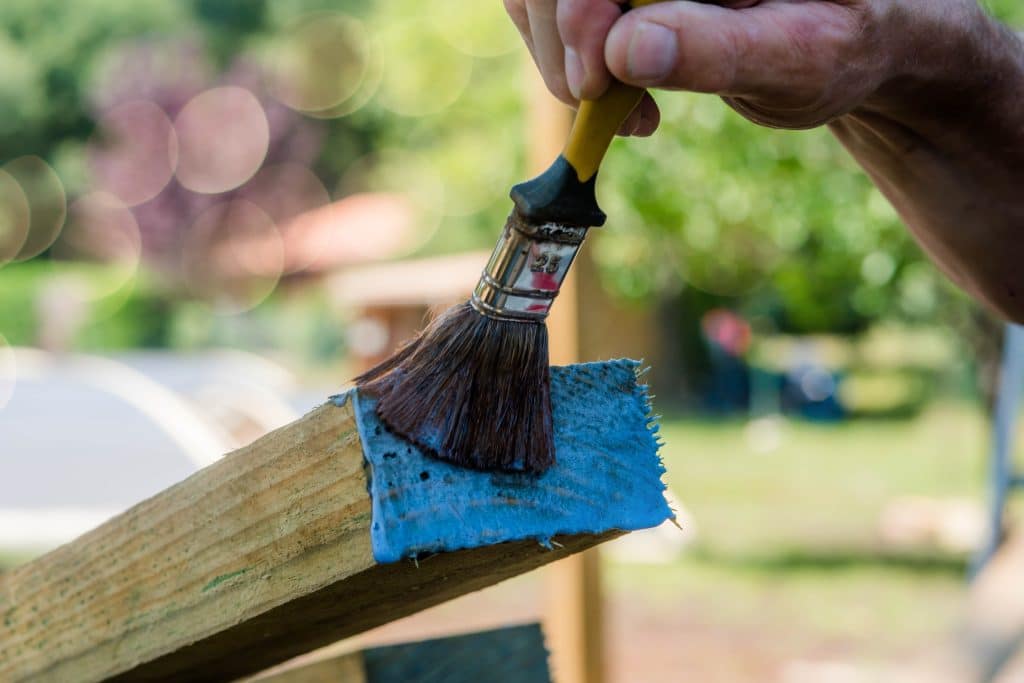
Liquid application: Dip diffusion treatment of green (wet) lumber Dip-diffusion treatment involves immersion of freshly cut lumber, still wet from the tree, in a concentrated solution of preservative. The preservative may be thickened to increase the amount of solution retained on the surface. The lumber is stacked, covered and stored for periods of weeks to allow the preservative to diffuse deep into the wood. In New Zealand, framing lumber has been treated with borates using this process since the 1950s. Dip-diffusion works well with wood species that are mostly sapwood or have wet heartwood. The ratio of the surface area to the volume, the amount of solution retained on the surface, and the solubility of the preservative limit the amount of chemical that can be delivered deep into the wood using this process. For example, a boric acid loading of 0.5% by weight of the wood, sufficient to prevent decay and beetle attack, can be applied to nominal 2 inch lumber using this process. However, a boric acid loading of 2.0% by weight, sufficient to prevent attack by Formosan termites, cannot be achieved without multiple dips and months of storage. Liquid application: Spray treatment of framing Since this type of treatment is typically done during the construction phase, it can be applied to the whole structure or to selected parts of the structure that are anticipated to be at risk from fungal decay or insect attack. Solids and fumigants are not appropriate for these applications, and the only widely used formulations are based on borates. Because the wood is dry at this stage, and because borates require moisture for diffusion, it helps if such treatments are formulated to improve penetration in dry wood. This is usually achieved by adding glycols. Nevertheless, the initial preservative penetration cannot be expected to be as good as that provided by a pressure treatment process. Spray applications of borate are becoming popular in certain regions of the USA as part of termite management systems. Typically, whole house superficial treatments are used to protect against drywood termites and wood boring beetles. This replaces regular fumigation. For subterranean termite protection, concentrated glycol borates may be applied to the bottom two feet of all wood in contact with the slab or, for crawl space construction, two feet up and inwards from the foundation. This replaces a soil barrier. Brush Application Brush applications for surface pre-treatment are basically limited to field-cut preservatives for pressure treated wood and homeowner treatment of structures, presumably with limited life expectancy. Copper naphthenate works well above ground or in ground contact, but its dark green colour (fading to brown after a year or so) is not very appealing. Zinc naphthenate is colourless and can be tinted to suit, but does not work as well in ground contact. Borates are typically used for field cuts on interior sill plates. In addition, borate/glycol mixtures are available for domestic use.
Depot Treatment
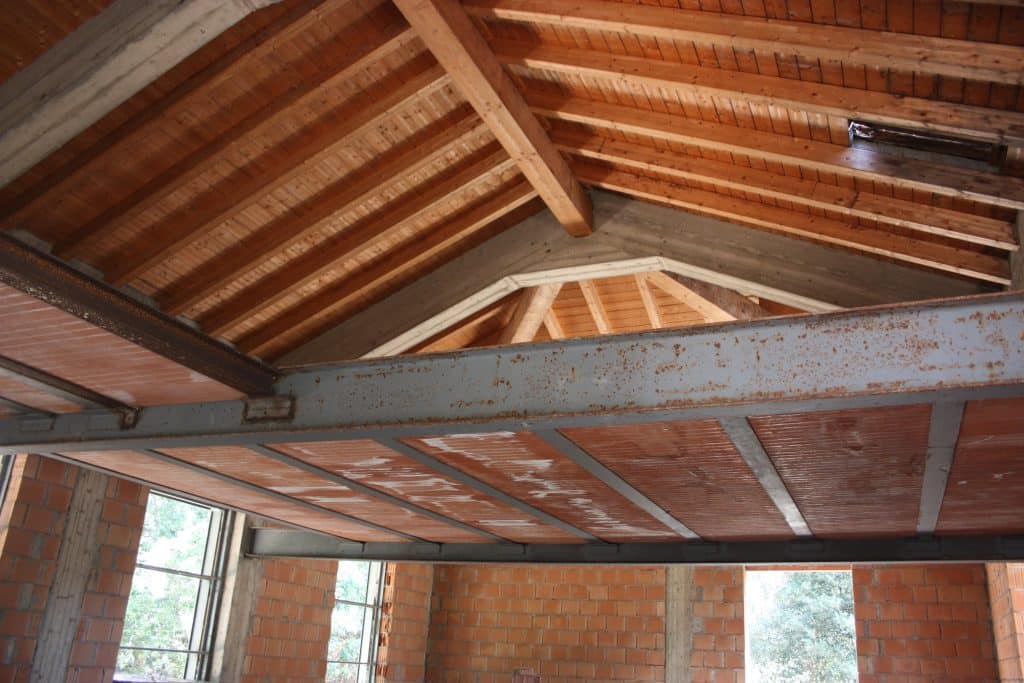
Since depot treatment is localized, it is critical that it be placed in the right location, which requires an understanding of how moisture may get into the structure. This can only be done when construction is complete or very near completion. At that point the degree of protection by design can be assessed and any water traps can be identified and, where possible, eliminated. The treatment can then be applied in the right location to intercept moisture close to its point of entry. Depot treatments are an excellent choice for a few common design applications such as partially exposed beams. When a beam penetrates the building envelope, only a portion is exposed to moisture and it makes sense to just treat that part. Depot treatments are especially useful for products that are not well-suited to pressure treatment with waterborne preservatives, like glulam. Similarly, depot treatments are appropriate for exposed log ends in log homes – logs that extend beyond the protective roof overhang are at risk of decay. Solids Depot treatments most commonly use a solid form of preservative. Borate, copper/borate and fluoride rods are highly suited to this end use since they are easy to install and the active ingredients only become mobile if moisture entry occurs. Other formats Pastes can be packed into drilled holes or routed grooves – log home grooves are an appropriate application. Liquid injection is less common, as this involves drilling small holes, inserting a pin nozzle injector connected to a 70 -120 psi tank/pump, and forcing preservative along the grain under pressure. A series of such holes is required, particularly for large dimensions, to increase loading. Less suited to depot treatments, fumigants have not, to our knowledge, been used in these applications.
Supplemental Treatment
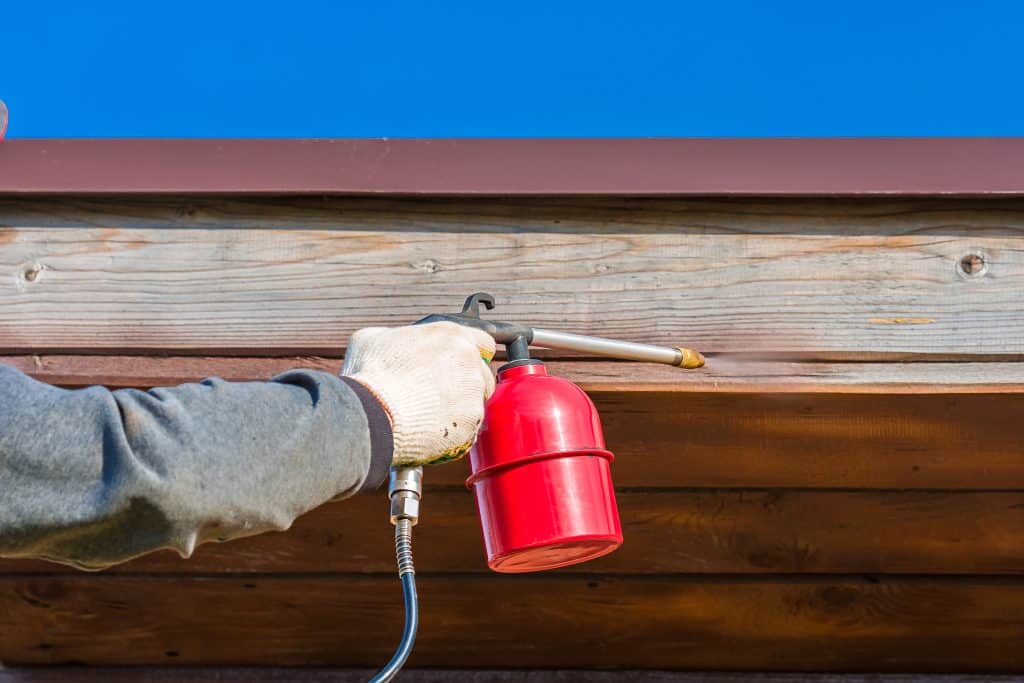
Supplementary treatment may be added wherever on-site cutting or drilling of wood is unavoidable, or where it is suspected the original protection measures may be inadequate. This is most commonly done in applications such as wood foundations, agricultural buildings, or non-residential long-life applications such as utility poles and bridge timbers. For wood foundations and agricultural buildings, it is normal to expect some end cutting and boring for bolts, pipes or electrical wiring. Typically copper naphthenate is brushed on the cut ends or holes in the treated wood to protect the exposed surfaces. Experience has shown that this is adequate for the limited exposure resulting from such cases. For cases such as poles or bridge timbers, the original preservative protection can be lost over time due to degradation or depletion of the active ingredients. A need for supplementary treatment may be indicated by damage to similar structures in the same area. Or there may be evidence that the risk of damage has increased, for example, if new termites move into the area. In cases like utility poles, where these are part of the physical infrastructure of an organization, inspection, maintenance and remediation are regularly practiced to ensure continued safety in use and to schedule replacement. Often the cost of supplementary treatment is relatively small compared to the cost of inspection, and is a very small fraction of the cost of premature failure. Supplementary treatment may also be prudent in terms of due diligence (reducing legal liability). During inspection of these structures, drills or increment borers may be used to determine the condition of the interior of the wood members. It is advised to treat these holes, to avoid infection from non-sterilized drills and borers. In addition, as holes are typically drilled where decay is suspected or anticipated, treating the holes is wise to supplement protection at that site. Solids Borate, copper/borate and fluoride rods have seen increasingly widespread use as supplementary treatments for internal decay due to their convenience in handling and very low toxicity. Copper moves more slowly in the wood than borate, providing protection to the zone around the rod if the borate is removed over time through mass flow of water. This is mainly of concern for utility poles in wet climates, where moisture moves into the pole from the soil, wicks up the pole and evaporates above ground, moving the borate up the pole with it – this leaves the borate in a part of the pole not especially at risk for decay. The rate of water flow may be relatively slow in Douglas fir (an impermeable wood species) treated with an oil-borne preservative having some water repellency. It may be more rapid in southern pine (a very permeable wood species) treated with a waterborne preservative. Liquids, Pastes and Gels Spray and foam application of liquids and gels are increasingly used for supplementary treatment of wood frame buildings against termites and wood boring beetles. Holes are drilled into each stud space and the liquids or gels are pumped in under pressure. Coverage cannot be expected to be as effective as that achieved by spray treatment during construction. Liquids can be poured or pumped into drilled holes to treat internal decay in utility poles or timbers. Typically the loading of preservative that can be achieved is limited in the first case by the size and location of the holes and the solubility of the chemical, and in the second case by the permeability of the wood. Another approach is to leave a pressurized device attached to the pole below ground, which pushes a larger amount of liquid into the pole over a longer time period. Care must be taken to ensure that drilled holes do not intersect voids or checks leading to the surface of the wood; otherwise, the liquids can flow out. Pastes can be packed into drilled holes to treat internal decay. Alternatively, they can be brushed or trowelled on or applied on bandages to treat external decay. Fumigants Fumigant treatments have been used successfully for decades on utility poles and timber structures. The gas moves rapidly through the wood, adsorbing to the lignocellulose and providing several years of residual protection.
Fasteners
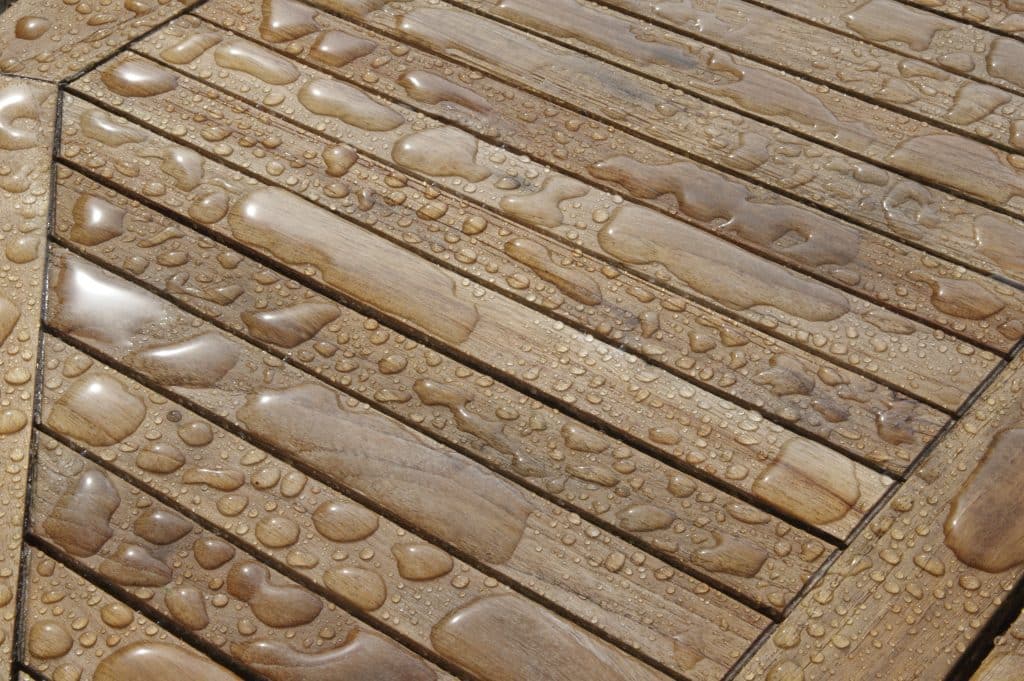
Fasteners, Connectors and Flashing for Wood Treated With Copper-Based Preservatives The presence of moisture is a precondition for corrosion of metals. Treated wood is typically used in applications where it may be exposed to moisture for considerable periods so any fasteners and connectors used with treated wood must also be resistant to these conditions. In addition, most wood preservatives designed for exterior use contain copper that may react with the metals used to fabricate fasteners and connectors therefore, it is important to use the right type of fastener and/or connectors. Where treated wood is used in dry environments to prevent damage by wood-destroying insects, including termites, corrosion is of less concern. Users and specifiers should also be aware that corrosive industrial, or salt air, environments may also require the use of appropriate corrosion resistant metals. Types of Wood Preserving Treatments Most copper-based preservatives are corrosive to unprotected fasteners and connectors. More recent systems such as MCA where the copper isn’t introduced in an ionic salt form, are designed to reduce the corrosion of metals, and the preserved wood is approved for use in contact with aluminum (e.g. brackets or outdoor furniture legs). Borate treatments do not increase the risk of corrosion. Recommendations on Connectors for Treated Wood Connectors used for wood treated with a copper-based preservative must be manufactured from steel either hot–dipped galvanized in accordance with ASTM A653 or hot dipped galvanized after manufacture in accordance with ASTM A123. Galvanizing nails and screws is actually a sacrificial coating to protect the structural integrity of the fastener, and the presence of some white corrosion product on the surface is normal. Red rust appearing is an indicator of coating failure. The service life of these components can be extended by using a barrier membrane between the connector and the treated wood surface. Stainless steel connectors (type 304 or 316) should be used for maximum service life, for high preservative retentions (i.e. ground contact products) or severe applications such as salt spray environments. For borate-treated wood used inside buildings, the same connectors can be used as for untreated wood. Recommendations on Fasteners for Treated Wood Fasteners for use in treated wood that will be exposed to the weather should be selected to withstand weathering as long as the treated wood itself. As a minimum, nails for wood treated with a copper-based preservative must be hot-dipped galvanized in accordance with ASTM A153. Hot-dipped galvanized nails should not be fastened using a high pressure nail gun due to the risk of damage to the coating during firing. The protective coating on electroplated galvanized fasteners is too thin and will perform poorly, and common nails will corrode rapidly after fastening most copper-based treated wood. Stainless steel should be used for maximum service life, for high preservative retentions or severe applications such as salt spray environments. Where appropriate, copper fasteners may also be used. Fasteners used in combination with metal connectors must be the same type of metal to avoid galvanic corrosion caused by dissimilar metals. For example stainless steel fasteners should not be used in combination with galvanized connectors. Screws intended for use on wood treated with a copper-based preservative must be hot dipped galvanized in accordance with ASTM A153 or, if recommended by the manufacturer and the preservative supplier, high-quality polymer coated. Stainless steel should be used for maximum service life, for high preservative retentions or severe applications such as salt spray environments. For borate treated wood used inside buildings, the same fasteners can be used as for untreated wood. As a general rule aluminum fasteners should not be used with treated wood, except new generation products (MCA treated) specifically tested, approved and labelled as suitable for contact with Aluminum. Recommendations on Flashing for Treated Wood Flashing used in contact with treated wood must be compatible with the treated wood and be last long enough to be suitable for the intended application. Flashing must also be of the same type of metal as any fasteners that penetrate through them to avoid galvanic corrosion. Copper and stainless steel are the most durable metals for flashing. Galvanized steel, in accordance with ASTM A653, G185 designation, is also suitable for use as flashing. Other Fasteners, Connectors or Hardware as Recommended by the Manufacturer There may be additional products such as polymer or ceramic coatings for fasteners, or vinyl or plastic flashings that are suitable for use with treated wood products. Consult the individual fastener, connector or flashing manufacturer for recommendations for use of their products with treated wood. Current Recommendations for Drying and Conditioning of Treated Wood Prior to Construction. Wood treated with copper-based preservatives should be at the least surface dried at the treating plant, in the store or at the job site before attachment of fasteners, connectors, flashing or other hardware. A moisture meter with a calibration for preservative treated wood should be used to verify that the wood is within a similar moisture content range to untreated construction lumber (i.e. about 12 to 18%) otherwise the treated wood can undergo similar shrinkage related cracking and deformation as incorrectly conditioned untreated lumber. Canadian Preservation Industry Canada has had a wood preservation industry for more than 100 years. Canada is tied with the UK as the world’s second largest producer of treated wood (the USA is first, by a large margin). In 1999, the most recent year for which we have data, Canada produced 3.5 million cubic metres of treated wood. There are about 60 treating plants in Canada. As with most other industrialized countries, Canada developed a wood preservation industry using creosote, initially to service railroads (the ties holding the rails) and then utilities (power poles). Creosote production began declining by the 1950s, and by the 1970s was being somewhat replaced for these traditional uses by pentachlorophenol. Today, these oil-borne preservatives only constitute 17% of Canadian treated wood production. The remaining 83% of production uses water-borne preservatives such as CCA, ACQ, CA and MCA. The industry began its substantial shift to the water borne
Treatability
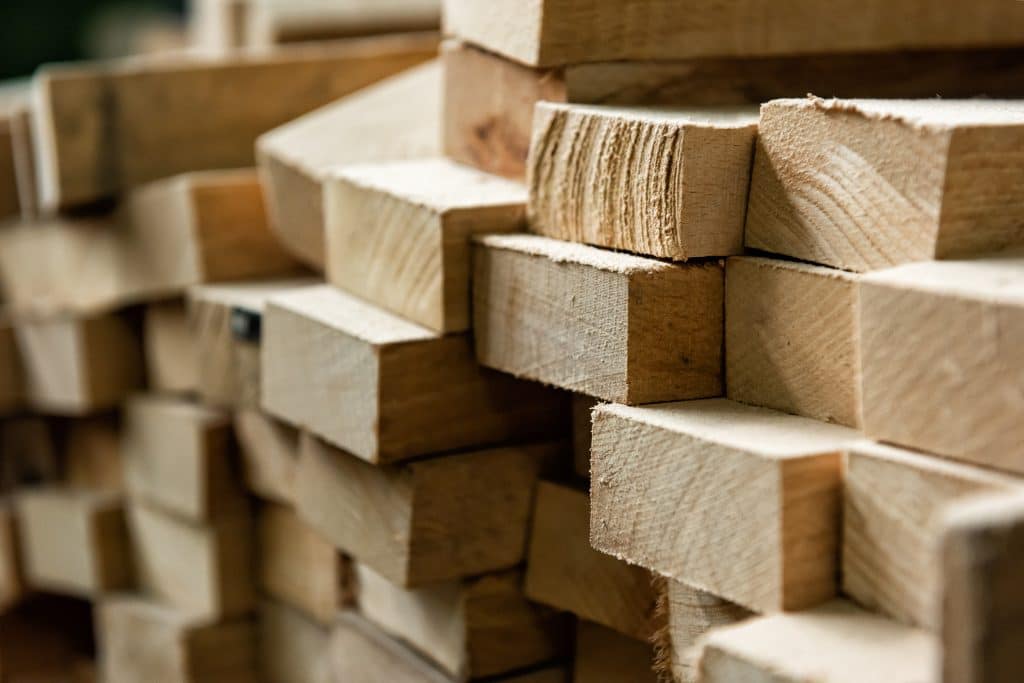
Treatability of Major North American Softwoods Some wood is easier to treat than others. The particular structure of the cells for a given piece of wood will determine how permeable the wood is to chemicals. This table describes the permeability of common softwoods used in North America. The permeability ratings are: 1 – Permeable 2 – Moderately Impermeable 3 – Impermeable 4 – Extremely Impermeable Tree Permeability Permeability Predominant in the Tree Sapwood Heartwood Douglas Fir 2 4 Heartwood Western Hemlock 2 3 Heartwood Eastern Hemlock 2 4 Heartwood White Spruce 2 3-4 Heartwood Engelmann Spruce 2 3-4 Heartwood Black Spruce 2 4 Heartwood Red Spruce 2 4 Heartwood Sitka Spruce 2 3 Heartwood Lodgepole Pine 1 3-4 Heartwood Jack Pine 1 3 Heartwood Red Pine 1 3 Sapwood Southern Pine 1 3 Sapwood Ponderosa Pine 1 3 Sapwood Amabilis Fir (Pacific silver fir) 2 2-3 Heartwood Alpine Fir 2 3 Heartwood Balsam Fir 2 4 Heartwood Western Red Cedar 2 3-4 Heartwood Eastern White Cedar 2 3-4 Heartwood Yellow Cypress 1 3 Heartwood Western S-P-F 2 3-4 Heartwood Eastern S-P-F 2 4 Heartwood Hem-Fir 2 3 Heartwood Western Larch 2 4 Heartwood Tamarack 2 4 Heartwood Incising We can improve the penetration of preservative into impermeable wood by making little cuts in the wood. A series of small, shallow slits are cut into the wood by an incising machine. This is an effective way of increasing the treatability of lumber pieces which are predominantly heartwood. Species with heartwood permeability ratings of higher than 3 require high density incising (over 7,500 incisions per square meter). Incising does reduce the strength of lumber and this effect must be taken into account in engineering calculations. Drying to Maximise Treatabilty Unless the purchaser can be assured that lumber for treatment will be air dried to less than 30% moisture content, the specification of KD lumber for preservative treatment is strongly recommended. The problem with treating lumber which is not kiln dried is that the practicalities of production and delivery lead to the potential for poor product quality. The durability of treated Canadian lumber relies on a shell of preservative treatment preventing access by wood-rotting fungi to the untreated core. If the treated shell fails to prevent penetration by checks or abrasion or if the wood-rotting fungus is already in the untreated core, premature failure can result. There are four major pitfalls in treating green lumber: saturated sapwood, frozen lumber, check development and pre-treatment infection. Saturated Sapwood In order for the preservative to penetrate the wood cells, they must be empty of water, that is, the wood must be below 30% moisture content. In green lumber the sapwood cells may be too full of sap to accept any preservative. The sapwood is the part most susceptible to decay and most in need of preservative penetration. Partial air or kiln drying to between 20 and 30% moisture content is ideal, but there is seldom the time or the conditions necessary to do this. Purchasing commercial KD material (maximum 20%) is normally the only option to ensure the sapwood will accept treatment. Frozen Lumber The overwhelming majority of production is treated over the winter to prepare for the spring and summer outdoor construction season. With the exception of coastal British Columbia, most regions of Canada will be dealing with frozen wood at this time. Many treating plants do not have dry kilns, thus material is treated in the condition it is delivered to the plant. Preservative will not penetrate through ice until it is fully thawed. This typically occurs in contact with the treating solution. Frozen green lumber contains a lot of ice and there is insufficient time for this to thaw during typical commercial treating cycles. The residual moisture (12 – 20%) in kiln-dried lumber is in the cell walls and will not impede preservative penetration even if it is frozen. Check Development Checks only develop when the moisture content of wood drops below about 28%. If lumber is treated green and then dries, checks will penetrate the treated zone exposing the untreated core. If lumber is kiln-dried to the in-service moisture content, typically around 16% in exterior exposure, the checks will be largely developed prior to treatment. This means that the checks will be lined with a treated zone and the shell of treatment will remain intact. Pre-treatment Infection A lesser problem than the above three, but still of some concern, is the potential for survival through the manufacturing process of wood-rotting fungi that may have infected in the tree, log or lumber storage stages. At worst, this might only apply to 10% or fewer of pieces. Nevertheless, we have seen examples where treatment of green lumber without application of heat (60°C or more) fails to kill wood-rotting fungi already in the product, leading to premature failure in service. This can occur in as little as 4 years. CCA treatment is a cool process, but most kiln-drying schedules will kill all wood-rotting fungi.
Resilience
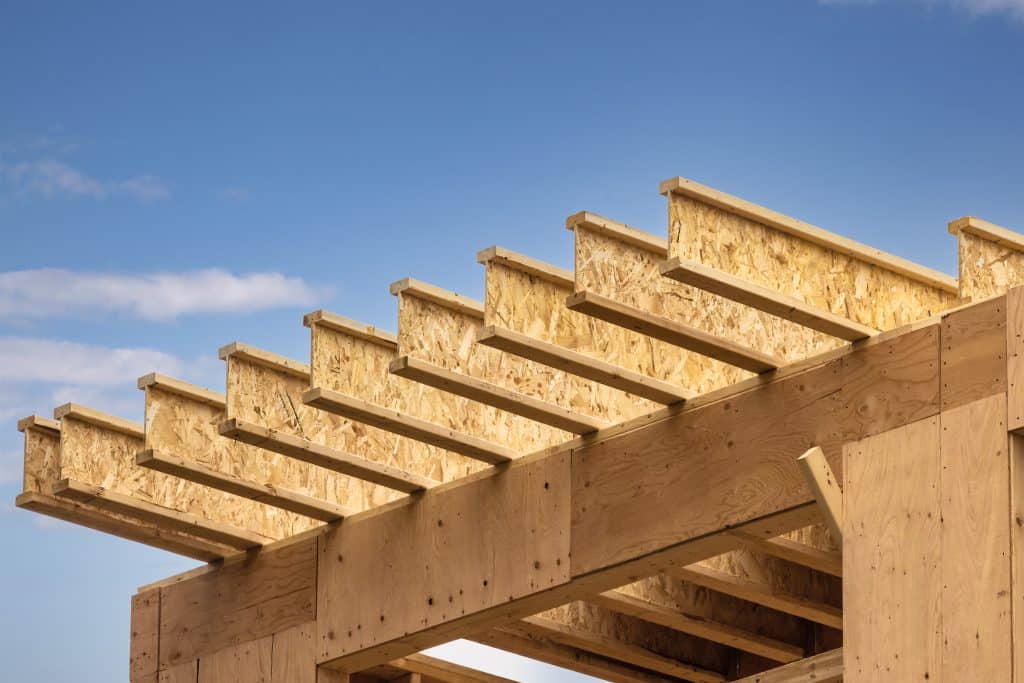
Individuals in the design and construction community are increasingly choosing materials, design techniques and construction procedures that improve a structure’s ability to withstand and recover from extreme events such as intense rain, snow and wind, hurricanes, earthquakes and wildfire. As a result, specifying robust materials and design details, and constructing flexible and easily repairable buildings are becoming important design criteria. Resilience is the ability to prepare and plan for, absorb, recover from, and more successfully adapt to adverse events. For a building, this means being designed to withstand and recover quickly from adverse situations such as flooding and high winds, with an acceptable level of functionality. A structure built to withstand such natural disasters with minimal damage is easier to repair and can contribute to sustainable development. Designing for resilience can contribute to minimizing human risk, reducing material waste and lowering restoration costs. As a result of shifting weather patterns due to climate change, there is a growing interest in adaptation and designing for resilience. Higher temperatures can increase the odds of more extreme weather events, including severe heat waves and regional changes in floods, droughts and potential for more severe wildfires. There are more intense and more frequent hurricanes, and precipitation often comes in the form of intense single-day events. Warmer winter temperatures cause water to evaporate in the air and if the temperature is still below freezing, this can lead to unusually heavy snow, sleet or freezing rain, even in years when snowfall is lower than average. A resilient building is able to deal with changes such as a heavier snow load, wider temperature fluctuations, and more extreme wind and rain. Existing wood buildings can be easily adapted or retrofitted if there is a need for increased wind or snow loading. Wood buildings that are properly designed and constructed perform well in all types of climates, even the wettest. Wood tolerates high humidity and can absorb or release water vapour without compromising the structural integrity. In some regions, climate change is seen to be contributing to increasingly complex wildfire seasons, which results in greater risk of extreme wildfire events. Some wildland fire regulations target specific construction features in wildland-urban interface areas, such as exterior decks, roof coverings, and cladding. A number of wood products meet these regulations for various applications, including heavy timber elements, fire retardant treated wood and some wood species that demonstrate low flame spread ratings (less than 75). For further information, refer to the following resources: Resilient and Adaptive Design Using Wood (Canadian Wood Council) American Wood Council American Institute of Architects
Moisture and Wood
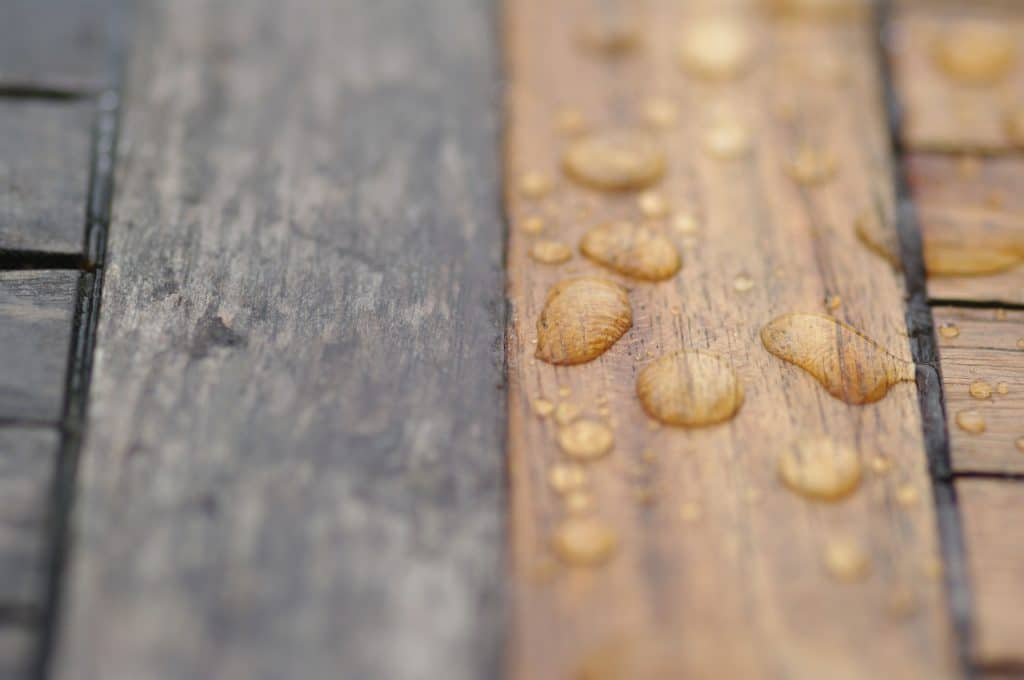
The durability of wood is often a function of water, but that doesn’t mean wood can never get wet. Quite the contrary, wood and water usually live happily together. Wood is a hygroscopic material, which means it naturally takes on and gives off water to balance out with its surrounding environment. Wood can safely absorb large quantities of water before reaching moisture content levels that will be inviting for decay fungi. Moisture content (MC) is a measure of how much water is in a piece of wood relative to the wood itself. MC is expressed as a percentage and is calculated by dividing the weight of the water in the wood by the weight of that wood if it were oven dry. For example, 200% MC means a piece of wood has twice as much of its weight due to water than to wood. Two important MC numbers to remember are 19% and 28%. We tend to call a piece of wood dry if it is at 19% or less moisture content. Fiber saturation averages around 28%. Fiber saturation is an important benchmark for both shrinkage and for decay. The fibers of wood (the cells that run the length of the tree) are shaped like tapered drinking straws. When fibers absorb water, it first is held in the cell walls themselves. When the cell walls are full, any additional water absorbed by the wood will now go to fill up the cavities of these tubular cells. Fiber saturation is the level of moisture content where the cell walls are holding as much water as they can. Water held in the cell walls is called bound water, while water in the cell cavities is called free water. As the name implies, the free water is relatively accessible, and an accessible source of water is one necessity for decay fungi to start growing. Therefore, decay can generally only get started if the moisture content of the wood is above fiber saturation. The fiber saturation point is also the limit for wood shrinkage. Wood shrinks or swells as its moisture content changes, but only when water is taken up or given off from the cell walls. Any change in water content in the cell cavity will have no effect on the dimension of the wood. Therefore, wood only shrinks and swells when it changes moisture content below the point of fiber saturation. Like other hygroscopic materials, wood placed in an environment with stable temperature and relative humidity will eventually reach a moisture content that yields no vapor pressure difference between the wood and the surrounding air. In other words, its moisture content will stabilize at a point called the equilibrium moisture content (EMC). Wood used indoors will eventually stabilize at 8-14% moisture content; outdoors at 12-18%. Hygroscopicity isn’t necessarily a bad thing – this allows wood to function as a natural humidity controller in our homes. When the indoor air is very dry, wood will release moisture. When the indoor air is too humid, wood will absorb moisture. Wood shrinks/swells when it loses/gains moisture below its fiber saturation point. This natural behaviour of wood is responsible for some of the problems sometimes encountered when wood dries. For example, special cracks called checks can result from stresses induced in a piece of wood that is drying. As the piece dries, it develops a moisture gradient across its section (dry on the outside, wet on the inside). The dry outer shell wants to shrink as it dries below fiber saturation, however, the wetter core constrains the shell. This can cause checks to form on the surface. The shell is now set in its dimension, although the core is still drying and will in turn want to shrink. But the fixed shell constrains the core and checks can thus form in the core. Another problem associated with drying is warp. A piece of wood can deviate from its expected shape as it dries due to the fact that wood shrinks different amounts in different directions. It shrinks the most in the direction tangential to the rings, about half as much in the direction perpendicular to the rings, and hardly at all along the length of the tree. Where in the log a piece was cut will be a factor in how it changes shape as it shrinks. One advantage of usingdry lumber is that most of the shrinkage has been achieved prior to purchase. Dry lumber is lumber with a moisture content no greater than 19%; wood does most of its shrinking as it drops from 28-19%. Dry lumber will have already shown its drying defects, if any. It will also lead to less surprises in a finished building, as the product will stay more or less at the dimension it was upon installation. Dry lumber will be stamped with the letters S-DRY (for surfaced dry) or KD (for kiln dry). Another way to avoid shrinkage and warp is to use composite wood products, also called engineered wood products. These are the products that are assembled from smaller pieces of wood glued together – for example, plywood, OSB, finger-jointed studs and I-joists. Composite products have a mix of log orientations within a single piece, so one part constrains the movement of another. For example, plywood achieves this crossbanding form of self-constraint. In other products, movements are limited to very small areas and tend to average out in the whole piece, as with finger-jointed studs.
Decay
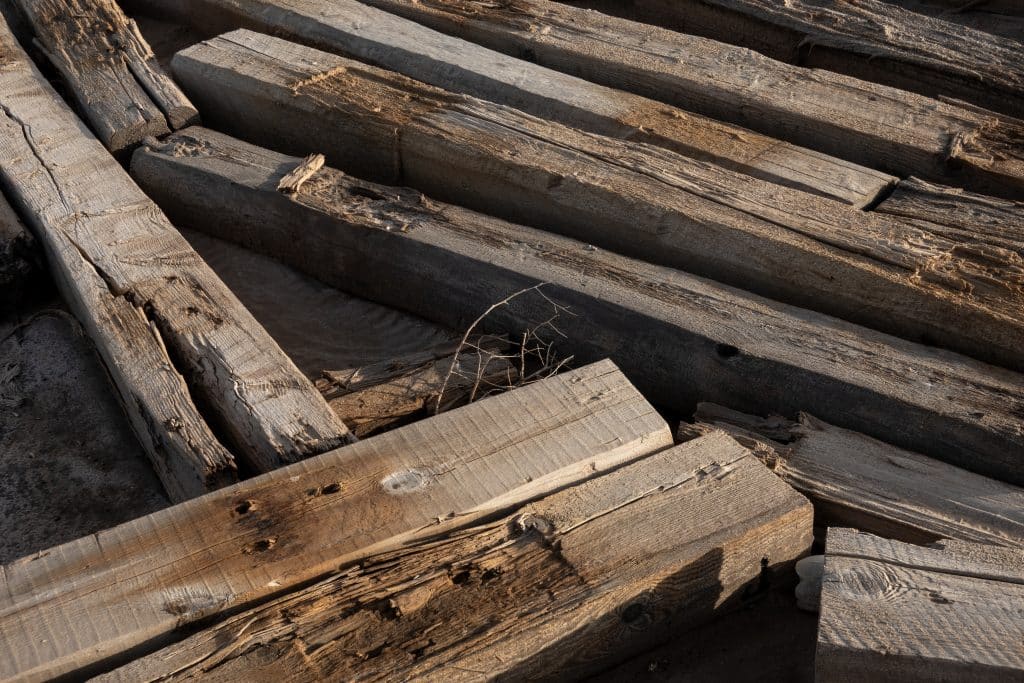
Wood is biodegradable – that’s a characteristic we normally consider to be one of the benefits of choosing natural materials. Organisms exist that can break down wood into its basic chemicals so that fallen logs in the forest can contribute to the growth of the next generation of life. This process – essential in the forest – must be prevented when we use wood in buildings. A variety of fungi, insects, and marine borers have the capability to break down the complex polymers which make up the wood structure. In Canada, fungi are a more serious problem than insects. The wood-inhabiting fungi can be separated into moulds, stainers, soft-rot fungi and wood-rotting basidiomycetes. The moulds and stainers can discolour the wood however they do not significantly damage the wood structurally. Soft-rot fungi and wood-rotting basidiomycetes can cause strength loss in wood, with the basidiomycetes the ones responsible for decay problems in buildings. With regard to insects, carpenter ants only cause problems in decayed wood, and significant subterranean termite activity is confined to a few southern areas of Canada. However, other parts of the world have a serious problem with termites. Decayed wood is the result of a series of events including a sequence of fungal colonization. The spores of these fungi are ubiquitous in the air for much of the year. Wood-rotting fungi require wood as their food source, an equable temperature, oxygen and water. Water is normally the only one of these factors that we can easily manage. This may be made more difficult by some fungi, which can transport water to otherwise dry wood. It can also be difficult to control moisture once decay has started, since the fungi produce water as a result of the decay process. The outer portion of this log is being attacked by a decay fungus. Note that the damage is held back at the line between heartwood and sapwood. To understand why, click here to read about natural durability. More Information Click Here for a 26-page paper on biodeterioration, including illustrations and bibliography. For answers to common questions on decay, visit the FAQ page
Termites
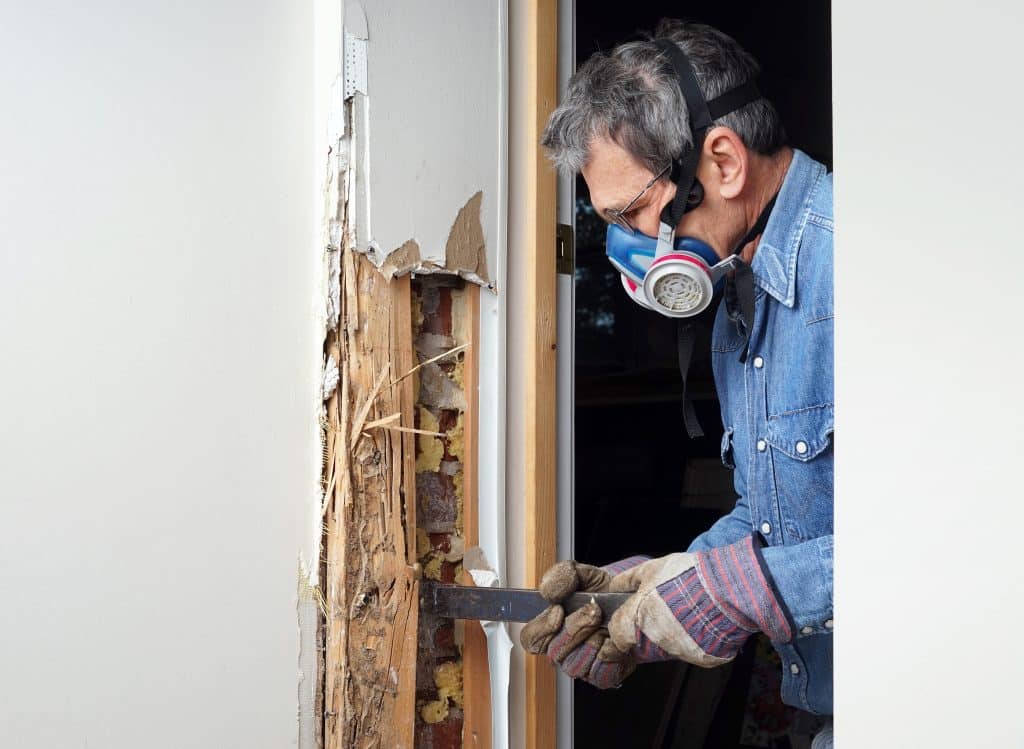
Termites, sometimes called “white ants” are a social insect, more closely related to cockroaches than ants. They can be distinguished from ants by the absence of a narrow waist on the body and their typically white colour. Under a hand lens, termite antennae are straight whereas those of ants have an elbow. Flying reproductive termites (alates) can be distinguished from flying ants by the equal size of all four termite wings. Three types of termites can be distinguished on the basis of their moisture requirements: Damp-wood termites Dry-wood termites Subterranean termites Damp-wood termites are particularly prevalent in coastal British Columbia and the Pacific Northwest of the USA. They only attack and help physically break down decaying trees in forest ecosystems and can be controlled by eliminating the moisture source which has led to decay. They are rarely a problem in buildings. Dry-wood termites on the other hand pose significant hazards to exposed, accessible wooden infrastructure, since they need no significant moisture source, and mated pairs can fly into buildings and start up a nest in dry wood. Consequently, control measures designed to separate wood from soil or moisture are ineffective. On the North American Continent, dry-wood termites are found only from the extreme south of the USA into Mexico. Subterranean termites do need a reliable source of moisture, normally the soil, but they have the capability to carry their required moisture needs into dry wood in buildings. Although satellite nests can occur in buildings, their main nests are normally in soil or wood in contact with soil. Subterranean termites build characteristic shelter-tubes (tunnels) of mud, wood fragments and bodily secretions, which allow them to pass from the soil to wood above ground without being exposed to drying air or predators. These shelter tubes can extend for several metres over inert substrates, such as concrete foundation walls. Termites can also pass through cracks in concrete as narrow as 1.5 mm. Within the subterranean group, one particular species: the Formosan termite (Coptotermes formosanus Shiraki), is the most problematic for wooden infrastructure. Although individuals are smaller than the species mentioned above, because of sheer numbers Formosan termite colonies can be nine times more aggressive in terms of wood consumption. This species is particularly problematic in parts of Southeastern USA, particularly Florida, where it was introduced after WWII. It is unlikely to spread north into Canada although Canada does have other, less-aggressive species of subterranean termites. Subterranean termites are the most economically important group worldwide. More Information Click here for a termite map of Canada. Click here for a termite map of SW Ontario. Click here for a termite map of British Columbia. Additional Sources of Information on Termites Louisiana State University Agricultural Center City of Guelph Municipality of Kincardine
Controlling Termites
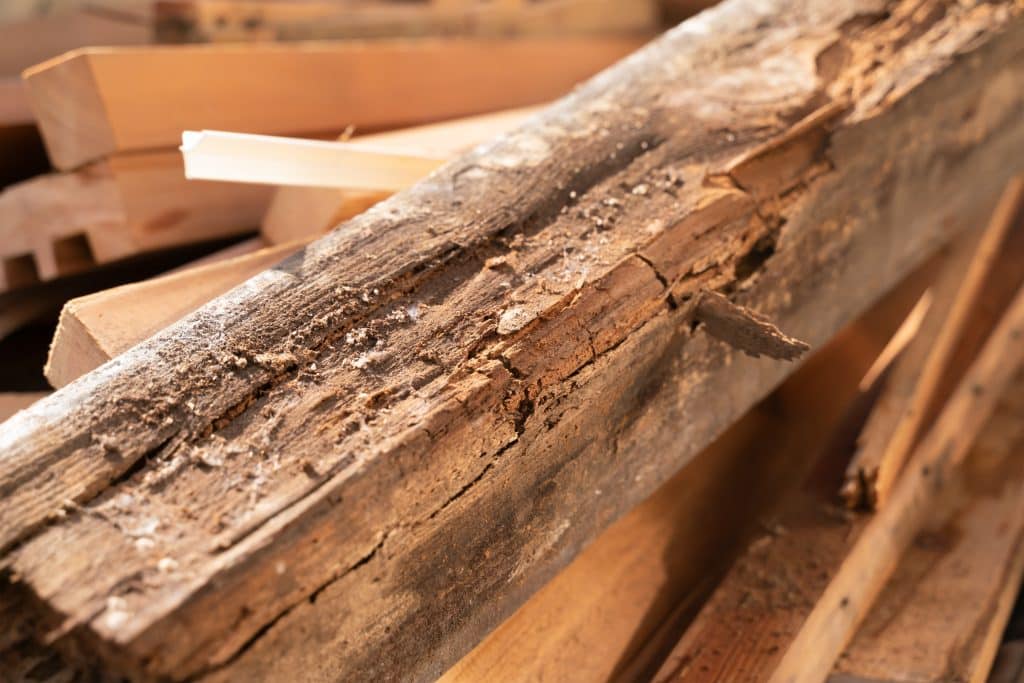
Fortunately for Canada, most of this country lies north of the limit for termites on the North American continent. However, because termites and people both prefer the warmer parts of this country, 20% of Canada’s population live in areas where termites are present. Long winters limit termite activity in the wild, but the warmth provided by our buildings seems to encourage more serious problems in urban environments. Damage caused by the Eastern subterranean termite, (Reticulitermes flavipes Kollar), has reached economically important levels in areas of Toronto and other cities in Southern Ontario. There are some suggestions that the Western subterranean termite, (Reticulitermes hesperus Banks), may be causing significant damage in the Okanagan region of British Columbia. Termites are a much more serious threat in many of our export markets such as the Southeastern USA, Japan and Southeast Asia. While termite control measures appropriate to each region are specified in local and regional building codes, an overview of such measures may be of use to Canadian marketers of wood products and manufactured homes. Termite control measures can be broadly grouped into six categories: Suppression Site Management Soil Barrier Slab/foundation details Structural durability Surveillance and Remediation Click Here for more details on the 6 strategies More Information Termite Control and Wood-Frame Buildings– 11-page illustrated bulletin from CWC, further covering the 6-point integrated strategy discussed. Includes photos of termite control products. Integrated Control of Subterranean Termites: The 6S Approach. This 20-page Forintek paper introduces and thoroughly discusses the 6-point integrated strategy. Includes very specific design and maintenance advice. Termite Map of North America Combatting Termites – very short and simple summary fact sheet from Forintek.
Applying Treatment
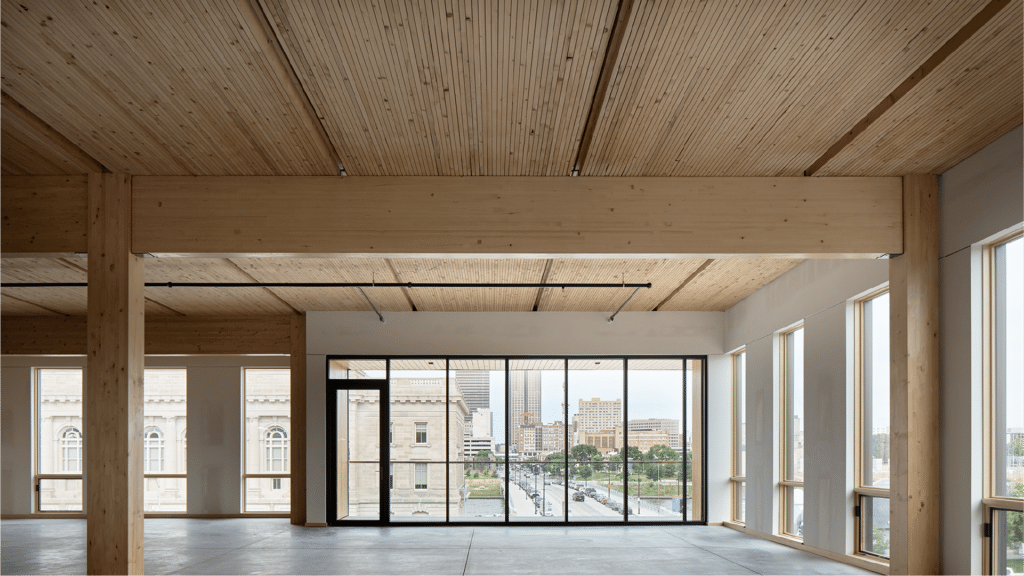
Holes drilled to apply depot, supplementary or remedial treatments should be on vertical surfaces or undersides, where possible, to avoid creating additional routes for moisture entry. In the case of supplementary treatment, cut ends should be placed so they are not in ground contact where possible. Holes for treatment should not be drilled below ground level if it can possibly be avoided. All holes should be closed with a tight-fitting plug. Ideally this should be removable to allow re-treatment. Holes for water-soluble treatments should be placed in the right locations to intercept moisture close to its points of entry. Look carefully at the structure and think about moisture sources, water traps, moisture entry points, moisture flow and signs of moisture entry. Moisture sources include direct rainfall, diverted rainfall (via windows, cladding, balcony and walkway surfaces, roof overhangs, flashing, parapets, eavestroughs and downspouts), rain penetration of moisture barriers via nail holes, splits, failure of joints or deterioration of caulking, rain splash, blowing snow, ice dams, condensation, concrete foundations, soil contact, irrigation systems, drain and plumbing leaks. Water traps include metal “shoes”, V joints, checks, appressed boards, cupped horizontal surfaces and anywhere a rim is created at the edge of a horizontal surface. Accumulation of dirt and debris often indicates a water trap. Growth of algae also indicates locations where moisture hangs around longer after rain. Moisture entry points include all locations with end grain, around nails, screws and bolts plus any other holes or penetrations, checks and delaminations. Moisture flow in wood may be 100 to 1000 times faster along than across the grain. Patterns of moisture distribution in wood are therefore commonly elongated cones or lens shapes centred on the point of entry. Signs of moisture entry include swelling, darker colouration, fungal stain, iron stain around fasteners, nail popping and flaking of film-forming surface finishes. Confirmation of moisture contents conducive to decay can be made using electrical-resistance type moisture meters. Capacitance-type moisture meters may also be useful, but these can give erroneous results in the area of metal fittings. Click Here for more information of field treatment
Preservative Treated Wood
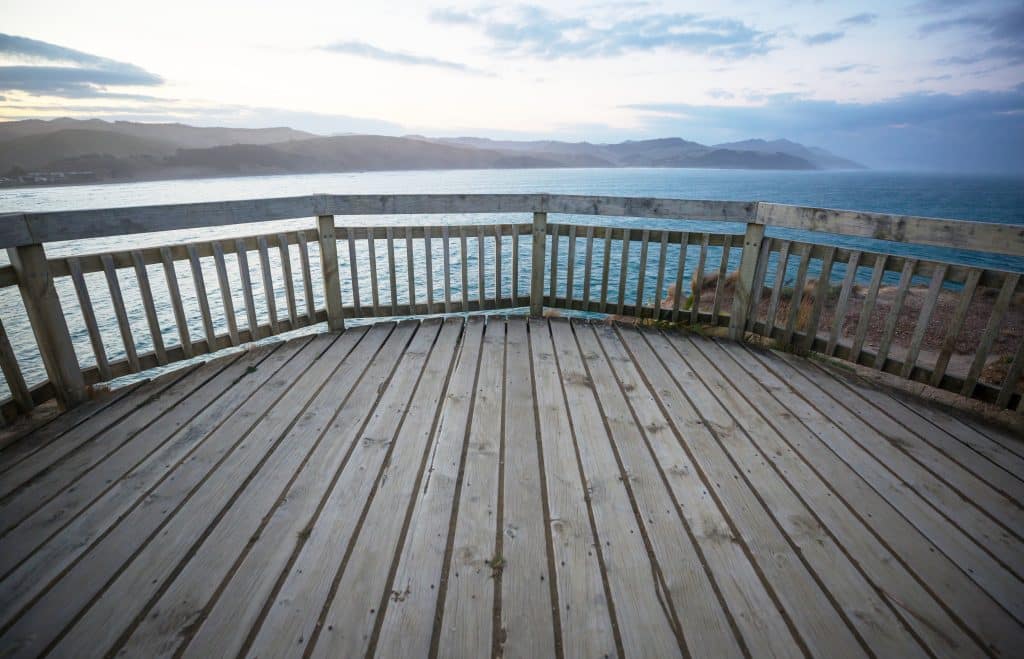
Preservative-treated wood is surface coated or pressure impregnated with chemicals that improve the resistance to damage that can result from biological deterioration (decay) due to the action of fungi, insects, and microorganisms. Preservative treatment offers a means for improving the resistance and extending the service life of those wood species which do not have sufficient natural resistance under certain in-use conditions. It is possible to extend the service life of untreated wood products by up to ten times through the use of preservative treatment. Preservative-treated wood can be used for exterior structures that require resistance to fungal decay and termites, such as: bridges, utility poles, railway ties, docks, marinas, fences, gazebos, pergolas, playground equipment, and landscaping. Four factors are necessary to sustain life for wood destroying fungi; a suitable food supply (wood fibre), a sustained minimum wood moisture content of about 20 percent (common for exterior use conditions), exposure to air, and a favourable temperature for growth (cold temperatures inhibit, but do not eliminate fungi growth). Preservative treatment is effective because it removes the food supply by making it poisonous to the fungi and wood destroying insects such as termites. An effective wood preservative must have the ability to penetrate the wood, neutralize the food supply of fungi and insects, and be present in sufficient quantities in a non-leachable form. Effective preservatives will also kill existing fungi and insects that might already exist in the wood. There are two basic methods of treating wood; with and without pressure. Non-pressure methods include the application of preservative by brushing, spraying or dipping the piece of wood. These superficial treatments do not result in deep penetration or large absorption of preservative and are typically restricted to field treatment during construction. Deeper and more thorough penetration is achieved by driving the preservative into the wood cells with pressure. Various combinations of pressure and vacuum are used to force adequate levels of chemical into the wood. For a wood preservative to function effectively it must be applied under controlled conditions, to specifications known to ensure that the preservative-treated wood will perform under specific in-use conditions. The manufacture and application of wood preservatives are governed by the CSA O80 series of standards. CSA O80 provides information on the wood species that may be treated, the types of preservatives and the retention and penetration of preservative in the wood that must be achieved for the use category or application. To ensure that the specified degree of protection will be provided, a preservative-treated wood product may bear a stamp indicating the suitability for a specific use category. Wood preservatives in Canada are governed by the Pest Control Products Act and must be registered with the Pest Management Regulatory Agency (PMRA) of Health Canada. Common types of wood preservatives that are used in Canada include chromated copper arsenate (CCA), alkaline copper quaternary (ACQ), copper azole (CA), micronized copper azole (MCA), borates, creosote, pentachlorophenol, copper naphthenate and zinc naphthenate. Acid salts can lessen the strength of wood if they are present in large concentrations. The concentrations used in preservative-treated wood are sufficiently small so that they do not affect the strength properties under normal use conditions. In some cases, the specified strength and stiffness of wood is reduced due to incising of the wood during the pressure impregnation process (refer to CSA O86 for further information on structural design reduction factors). Hot dipped galvanized or stainless steel fasteners and connection hardware are usually required to be used in conjunction with preservative-treated wood. There may be additional materials, such as polymer or ceramic coatings, or vinyl or plastic flashings that are suitable for use with preservative-treated wood products. The manufacturer should be consulted prior to specification of fasteners and connection hardware. For further information, refer to the following resources: www.durable-wood.com Wood Preservation Canada Canadian Wood Preservation Association CSA O80 Series Wood preservation CSA O86 Engineering design in wood Pest Management Regulatory Agency of Health Canada American Wood Protection Association



